Cause of death Stomach cancer Children 2 Occupation Dress manufacturer | Nationality American Role Clothing manufacturer Resting place Emanu-El Cemetery Name Abraham Zapruder | |
 | ||
Spouse Lillian Zapruder (m. 1933–1970) Similar People Lee Harvey Oswald, John Connally, Mary Moorman, J D Tippit, Clint Hill | ||
Organizations founded Jennifer Juniors Died August 30, 1970 (aged 65) Dallas, Texas, U.S. | ||
Abraham Zapruder (May 15, 1905 – August 30, 1970) was a Russian-born American clothing manufacturer who witnessed the assassination of President John F. Kennedy in Dallas, Texas, on November 22, 1963. Zapruder unexpectedly captured the event in a home movie while filming the presidential limousine and motorcade as it traveled through Dealey Plaza.
Contents
- A camera s view of jfk s murder abraham zapruder film alterations exposed
- Background
- Filming of assassination
- Television interview
- Sale of rights
- Testimony
- Death
- In popular culture
- References

A camera s view of jfk s murder abraham zapruder film alterations exposed
Background

Zapruder was born into a Russian Jewish family in the city of Kovel, the Russian Empire (now Ukraine). He received only four years of formal education in Russia. In 1920, amid the turmoil of the Russian Civil War, his family emigrated to the United States, settling in Brooklyn, New York. Studying English at night, he found work as a clothing pattern maker in Manhattan's garment district. In 1933, he married Lillian Sapovnik (1913–1993), with whom he had two children. Zapruder was a Freemason and an Inspector-General (33rd degree) of the Scottish Rite.

In 1941, Zapruder moved to Dallas, Texas, to work for Nardis, a local sportswear company. In 1949 he co-founded Jennifer Juniors, Inc., producing the Chalet and Jennifer Juniors brands. His offices were on the fourth floor of the Dal-Tex Building, across the street from the Texas School Book Depository.
Filming of assassination
At the time of the assassination, Zapruder was an admirer of President Kennedy and considered himself a Democrat. Zapruder had originally planned to film the motorcade carrying President Kennedy through downtown Dallas on November 22, but decided not to film the event as it had been raining that morning. When he arrived at work that morning without his camera, Zapruder's assistant insisted that he retrieve it from home before going to Dealey Plaza because the weather had cleared.
Zapruder's movie camera was an 8 mm Bell & Howell Zoomatic Director Series Model 414 PD—top of the line when it was purchased in 1962. Zapruder had planned to film the motorcade from his office window but decided to choose a more optimal spot in Dealey Plaza where the motorcade would be passing. He chose to film on top of a 4-foot (1.2 m) concrete abutment which extends from a retaining wall that was part of the John Neely Bryan concrete pergola on the grassy knoll north of Elm Street, in Dealey Plaza. Zapruder's secretary, Marilyn Sitzman, offered to assist Zapruder as he suffered from vertigo and was apprehensive about standing on the abutment alone. While Sitzman stood behind Zapruder and held his coat to steady him, he began filming the presidential motorcade as it turned on Houston Street onto Elm Street in front of the Book Depository. Zapruder's film captured 26.6 seconds of the traveling motorcade carrying President Kennedy on 486 frames of Kodak Kodachrome II safety film. Zapruder's film captured the fatal head shot that struck President Kennedy as his limousine passed almost directly in front of Zapruder and Sitzman's position, 65 feet (20 m) from the center of Elm Street.
Zapruder would later recall that he immediately knew that President Kennedy's wound was fatal as he saw the president's head "...explode like a firecracker." Walking back to his office amid the confusion following the shots, Zapruder encountered The Dallas Morning News reporter Harry McCormick, who was standing near Zapruder and noticed he was filming the motorcade. McCormick was acquainted with Agent Forrest Sorrels of the Secret Service's Dallas office and offered to bring Sorrels to Zapruder's office. Zapruder agreed and returned to his office. McCormick later found Sorrels outside the Sheriff's office at Main and Houston, and together they went to Zapruder's office.
Zapruder agreed to give the film to Sorrels on the condition it would be used only for investigation of the assassination. The three then took the film to the television station WFAA to be developed. After it was realized that WFAA was unable to develop Zapruder's footage, film was taken to Eastman Kodak's Dallas processing plant where it was immediately developed later that afternoon. As the Kodachrome process requires different equipment for duplication than for simple development, Zapruder's film was not developed until around 6:30 p.m. The original developed film was taken to the Jamieson Film Company, where three additional copies were exposed; these were returned to Kodak around 8 p.m. for processing. Zapruder kept the original, plus one copy, and gave the other two copies to Sorrels, who sent them to Secret Service headquarters in Washington.
Television interview
While at WFAA, Zapruder described on live television the assassination of President Kennedy:
Sale of rights
Late that evening, Zapruder was contacted at home by Richard Stolley, an editor at Life magazine (and first editor of the future People magazine). They arranged to meet the following morning to view the film, after which Zapruder sold the print rights to Life magazine for $50,000. Stolley was representing Time/Life on behalf of Publisher Charles Douglas Jackson.
The following day (November 24), Life purchased all rights to the film for a total of $150,000 (approximately $1,173,000 today).
The night after the assassination, Zapruder said that he had a nightmare in which he saw a booth in Times Square advertising "See the President's head explode!" He determined that, while he was willing to make money from the film, he did not want the public to see the full horror of what he had seen. Therefore, a condition of the sale to Life was that frame 313, showing the fatal shot, would be withheld. Although he made a profit from selling the film, he asked that the amount he was paid not be publicly disclosed. He later donated $25,000 (about $196,000 today) of the money he was paid to the widow of Officer J. D. Tippit, a Dallas police officer who was shot and killed by Lee Harvey Oswald 45 minutes after President Kennedy was killed.
In 1975, Time, Inc. (which owned Life magazine) sold the film back to the Zapruder family for $1. In 1978, the Zapruders allowed the film to be stored at the National Archives and Records Administration where it remains. In 1999, the Zapruders donated the copyright of the film to the Sixth Floor Museum at Dealey Plaza.
Testimony
In his testimony to the Warren Commission, Zapruder was asked for his impression regarding the direction of the shots:
Zapruder added that he had assumed the shots came from behind him because the President's head went backwards from the fatal shot, and also that the wound on the side of the President's head was facing that direction. He also said he believed it because police officers ran to the area behind him.
He broke down and wept as he recalled the assassination, and did so again at the 1969 trial of Clay Shaw.
Death
Zapruder died of stomach cancer in Dallas on August 30, 1970, and is buried in the Emanu-El Cemetery in Dallas.
